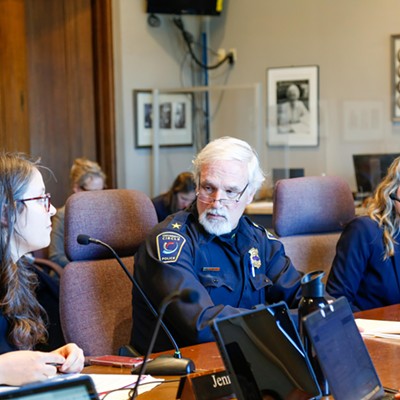Joseph Gallagher School on Cleveland's west side has been in Academic Emergency — the equivalent of receiving an 'F' on the State of Ohio report card — for over 10 years. Yet beneath the simple, all-too-easy label of "failing school" is a tough, caring place that refuses to give up on its kids or accept poverty as an excuse for poor performance.
Given all the challenges facing Gallagher, a K-8 school with about 650 students, its teachers and principal might be forgiven for harboring doubts. It serves refugees from war-torn countries in Africa, special education and medically fragile students from across the city, and youngsters from a few blocks away. It is one of the most diverse schools in the Cleveland Municipal School District (CMSD), yet hardly exceptional.
Nearly 75 percent of Cleveland schools are currently rated as being in Academic Watch or Academic Emergency, the lowest scores on the state report card. The district also has 14 "new and innovative" schools created within the past five years that are ranked Continuous Improvement or higher, as well as other high-performing schools. Despite slow, steady gains made in recent years, however, most of the schools are failing.
CEO Eric Gordon's efforts to improve the schools have so far been hampered by excruciating budget cuts. In the past two years, CMSD has suffered massive budget shortfalls because of state funding cuts under Governor John Kasich, lower enrollment numbers, declining tax revenues and rising labor costs. As a result, it has cut over 500 teaching positions (nearly 10 percent of its workforce), chopped electives like art, music and gym, pared 50 minutes from the school day and trimmed back budgets for basic things like art supplies and paper.
Still, it hasn't been enough. Next year, without a new school levy, CMSD will confront a budget shortfall of about $50 million — forcing it to cut another 700-800 staff positions, close schools, eliminate preschool and busing, and likely face state control as well.
To make matters worse, CMSD has received a failing grade on this year's report card, slipping from Academic Watch to Academic Emergency once again. Gordon, who is "devastated" by the rating, says that it is partially the result of two years of cuts that caused class sizes to balloon to 30-45 kids in many schools.
If it passes, Issue 107, the levy on the Nov. 6 ballot, would go a long way toward solving these problems, raising an estimated $77 million annually. But it asks a lot from city residents: 15 mills, the largest millage in recent Northeast Ohio history. The number is high because property values have fallen and collection rates are low. And CMSD officials want to do more than just restore the cuts — they want to move the district forward. Still, the levy would cost the average Cleveland homeowner $300 per year, assuming an average home price of about $64,000.
"It has to pass," says Gordon, who cites the fact that CMSD made slow, steady gains between 2006 and 2011 and is poised to do so again as reasons why voters should support it. A new school levy has not passed in the City of Cleveland since 1996.
"We are seeing a community-wide effort to address learning across the city," Gordon adds optimistically. "I am very confident in the people of the City of Cleveland. In the long term, they know the city's strength will be driven by the quality of our schools."
Gordon's campaign-mode optimism may be a ray of sunshine, but is it real? The stark reality is that many city residents have little personal knowledge of the schools; those who do often have long memories of past failures. CMSD has lost 30,000 students in the past decade, and only 14 percent of residents have kids in the schools. As a result, the district faces a major challenge in communicating its potential for success.
There are currently 38,000 students in 102 CMSD schools, a drop of nearly 2,500 students in the last year alone, with many of those going to new charter schools. The declining population is mirrored in the state report card, which rates schools in six categories ranging from Academic Emergency to Excellent with Distinction. CMSD was in Academic Emergency in 2004-05, climbed to Continuous Improvement by 2009-10, then slipped into Academic Watch the following year.
Along with those ratings, what most residents see is the problems of a school like Gallagher, which is in many ways a microcosm of the challenges facing the Cleveland school district. A blizzard of acronyms paints a disheartening picture:
Some 36 percent of Gallagher students have an IEP, or Individual Education Plan, which is required for special education students with problems ranging from autism to attention deficit disorders. A total of 52 percent are LEP, limited in their English-language proficiency. A number of students are also ED (Emotionally Disturbed) or OHI (Other Health-Impaired). The health problems are so severe that Gallagher is one of only two schools in the district with two full-time nurses on staff.
Yet the acronyms Principal Jennifer Rhone prefers to cite are AYP (Adequate Yearly Progress) and PI (Performance Index), the numbers that the state uses to determine how well individual schools are doing. During the 2011-2012 school year, Gallagher achieved a score of 69.9 on the PI. That's up from 62.3 five years ago and 69.1 during the previous school year. Yet it's still shy of 70, the magic number that would move the school up to an Academic Watch rating.
"It's absolutely heartbreaking," Rhone says of the score. "We've seen slow, steady growth, but it hasn't been fast enough."











